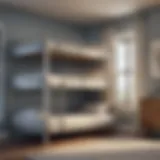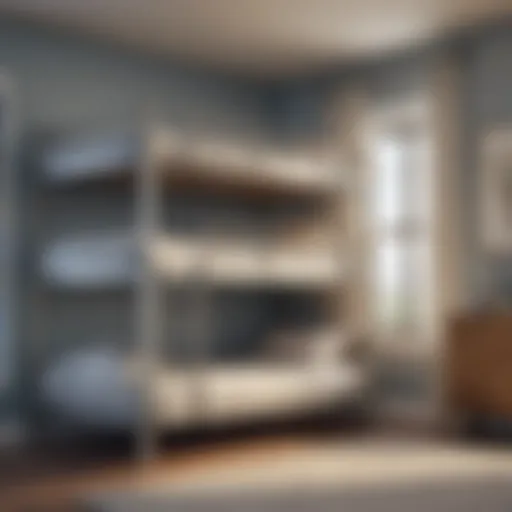Understanding Curtain Rod Installation Costs
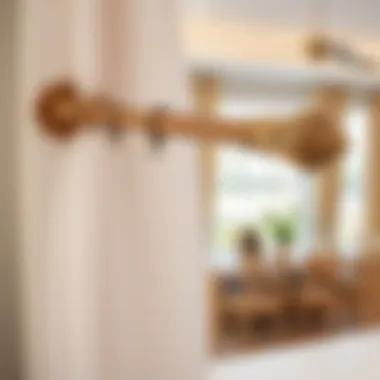
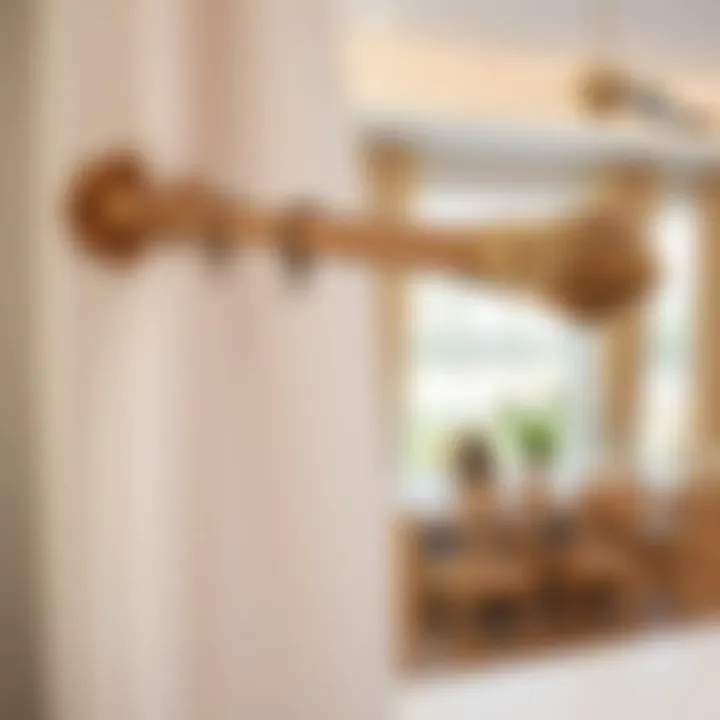
Intro
When diving into the world of home decor, one element often whispers sophistication and a touch of elegance more than any other – curtains. Hanging them effectively is the unsung hero of dressing a window, and behind that seamless aesthetic lies a complex tapestry of factors influencing the cost of curtain rod installation. Homeowners and design enthusiasts alike must navigate the twists and turns of materials, labor costs, and design choices to make informed decisions.
In this article, we will unfold the layers of curtain rod installation expenses, ensuring readers are well-equipped to manage their budgets without compromising on style. Whether you are a DIY aficionado or working with professionals, understanding these nuances is pivotal. Plus, we'll throw in some practical tips to keep those rods and curtains looking fresh for longer.
Let’s embark on this journey to transform your space with knowledge and confidence.
Preface to Curtain Rod Installation Costs
When considering the aesthetic and functional aspects of a room, curtains can play a significant role. However, the curtain rods that support these window treatments are just as crucial, and the costs associated with their installation should not be overlooked. Understanding the curtain rod installation costs is more than just a number; it is a blend of material choices, labor expenses, and the unique features of your space.
In the realm of interior decor, a well-chosen curtain rod can enhance the beauty of your curtains and ultimately contribute to the overall ambiance of your home. It might seem like a minor detail, but when you consider the variety of styles and materials available, as well as the intricacies involved in installation, it's clear why it's worth delving deeper.
The importance of this topic lies in its ability to inform homeowners and designers about potential budget implications. When embarking on redecorating or renovating, being financially prepared is essential. For instance, some might envision a sleek metal rod to complement modern decor, while others may prefer a rustic wooden option. Each material comes with its price tag, and knowing what to expect can guide your choices.
Additionally, the installation process can vary significantly. Factors such as window size and shape, the complexity of the installation, and the type of curtains can influence labor costs.
"Informed choices lead to a satisfying home environment."
If you're handy at home improvement projects, DIY savings are possible. However, hiring professionals might be the best route for intricate setups. The goal is to ensure that the curtain rod is mounted securely and aligns with your design vision.
Factors Influencing Curtain Rod Installation Costs
When it comes to installing curtain rods, there’s much more at play than just picking a rod and sticking it up on the wall. The costs associated with such a project can vary in a plethora of ways. It's not merely about the price of materials; there are several factors that pulls and pushes the final numbers in one direction or another. Let's dive headfirst into these influences so you can get the full picture.
Type of Curtain Rod
The type of curtain rod selected stands tall as a main anchor in determining your expenses. Different materials and designs come with their own price tags, affecting the overall budget in significant ways.
Wooden Rods
One striking feature of wooden rods is their timeless charm. They add a cozy touch to a room, making them a popular choice for traditional interiors. These rods can be found in a variety of stains and finishes, which provides ample options for matching or contrasting with existing decor. However, their weight and sturdiness may also contribute to a higher overall installation cost due to the need for robust brackets. While wooden rods can be a bit pricier upfront, homeowners appreciate their longevity, which may justify the investment over time.
Metal Rods
Holing their own in the realm of curtain rods, metal rods are often the go-to for modern aesthetics. Made typically from materials like steel or aluminum, they offer durability and sleekness that appeals to many design aficionados. Their ability to support heavy curtains without sagging makes them a wise option for rooms with large windows or heavy draping. However, they can be prone to rusting or bending if not well-maintained, which could lead to additional costs down the line.
Tension Rods
Tension rods present a flexible solution, particularly in spaces where the installation of permanent fixtures is not an option. They are known for their ease of use, often requiring no tools for installation. While they're affordable and convenient, they may not endure as well as sturdier rods when carrying heavier fabrics. This could lead to a temporary aesthetic, meaning you might end up spending more replacing them over time.
Double Rods
Double rods are the unsung heroes for those looking to layer curtains for both aesthetic and functional benefits. They allow one to hang sheers alongside heavier drapes, creating a pleasing look that enhances light filtering options. However, this added complexity can ramp up labor and material costs due to the need for additional mounting hardware. While they can elevate the overall feel of a room, potential buyers should weigh that against the extra costs they’ll incur.
Installation Complexity
Diving deeper, the complexity of the installation process can significantly alter your financial investment. The more intricate the setup, the higher the pay out on labor and materials.
Standard Installation
A straightforward installation involves using pre-existing brackets and simple measurements. This type usually means minimum overhead in terms of both material and labor costs. If your space allows for this kind of simplicity, the result can be wallet-friendly without sacrificing quality.
Custom Solutions
If your curtains require a tailored approach, custom solutions can provide just that. These often involve special hardware or unique rod lengths that cater specifically to the nuances of your room design or window size. While customization can deliver stunning results, it also tends to drive up spending, as you’re paying for specialized craftsmanship.
Reinforcement Needs
For heavy drapery or unique window shapes, extra reinforcement might be necessary. Heavy-duty brackets, special anchors, and additional support systems will come at a cost, but they’re essential for ensuring your curtains hang as intended. Skipping out on this essential step could result in disappointment if your curtains sag or pull at the installation site, necessitating further expenses for repairs.
Window Size and Shape
Your window’s particular characteristics can also fluctuate curtain rod installation costs significantly. Not all windows are created equal; their sizes and shapes can introduce unique hurdles.
Standard Windows
For most homeowners, standard or rectangular windows are a familiar sight. Installation for these types typically runs smoothly, which harmonizes well with both material and labor costs. The expected pricing tends to be less since there aren’t unique requirements to contend with.
Arched Windows
The elegance of arched windows comes with its fair share of complications. Fitting curtain rods on these curvy forms often needs specialized hardware and a careful hand to ensure that the curtains hang correctly without obstructions. This may drive costs higher due to the specifics involved in the installation and the potential need for custom rods.
Bay Windows
Bay windows present a mixture of aesthetic beauty and a practical challenge. With angles that require careful angles and planning, installing rods in these areas often requires additional materials and more skilled labor. Homeowners must balance the charm of bay windows with the understanding that installation might not come cheap. However, the final result can often transform a room into something truly special, making the investment worthwhile.
Material Costs Breakdown
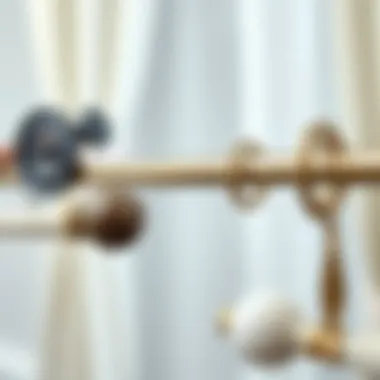
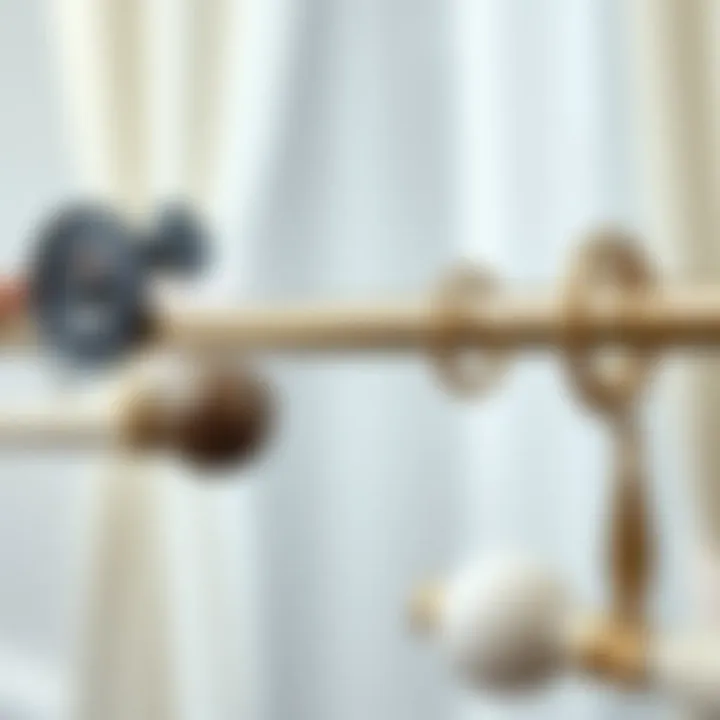
Curtain Rod Materials
Cost of Wood
Wooden curtain rods are often celebrated for their warmth and classic aesthetics. A primary aspect to consider is the variety of wood available—from pine and cedar to more premium options like oak and mahogany. The cost typically ranges from $15 to $100 depending on the type, length, and finish.
One key characteristic of wooden rods is their ability to blend seamlessly with various decor styles, making them a popular choice. The natural patterns and textures found in wood can bring a rustic or sophisticated ambiance to a space. However, one unique aspect of wooden rods is their susceptibility to warping or cracking if not well-maintained. Therefore, it's crucial to think about humidity levels and cleaning methods long-term.
Overall, wooden rods are a beautiful choice, bringing elegance but requiring a bit more attention to upkeep compared to other materials.
Cost of Metal
Metal rods, which typically range from $20 to $150, are known for their strength and modernity. Materials like stainless steel, wrought iron, or aluminum are common options. The standout characteristic of metal is its durability; not only do they hold heavier drapes with ease, but they also resist bending or breaking.
Metal rods lend a sleek, contemporary feel to interiors, aligning well with industrial or minimalist design themes. A notable feature is the finish options available, from matte to chrome, allowing endless design flexibility. However, while they can be more resilient, metal rods may conduct temperature, leading to condensation, which can affect curtains if not taken into account during installation. Overall, metal is a robust choice, excellent for those prioritizing longevity and style.
Cost of Plastic
Plastic curtain rods represent the most budget-friendly option, commonly costing between $10 to $30. They are lightweight and easily adaptable, suiting a range of needs, especially in temporary or rental situations. An attractive trait of plastic is its resistance to moisture, which makes it a viable choice for kitchens or bathrooms where humidity levels can be high.
However, a downside to plastic rods is their tendency to lack the visual appeal of wood or metal, leading to a more utilitarian look. They also may not support heavier drapes as well as their counterparts. Nevertheless, for those who need cost-effective solutions that require little maintenance, plastic could be an interesting solution to consider in any project.
Brackets and Mounting Hardware
Standard Brackets
Standard brackets are essential components in the installation process, usually falling in the $5 to $15 range. Their primary job is to support the curtain rods and keep them securely in place. What’s compelling about standard brackets is their variety of styles and finishes, catering to diverse design themes while being functional.
The unique aspect of standard brackets is the ease of installation. Most homeowners can install them with minimal tools and skills, making these brackets a popular choice for DIY enthusiasts. However, while they offer solid support, one should be aware that not all standard brackets will accommodate adjustable rods or heavier fabric. Thus, understanding weight limits is crucial to avoid any mishaps later on.
Specialty Hardware
Specialty hardware includes advanced mounting options and supports that may cost anywhere from $20 to $100 or more. This can range from L-shaped brackets to ceiling mounts or heavy-duty supports, depending on the nature of the installation. The key feature here is functionality; specialty hardware is usually designed to address specific needs, like high ceilings or particularly heavy window treatments.
A big advantage is their ability to provide enhanced support for complex rod configurations, making them indispensable for customized installations. However, the use of specialty hardware often entails a more complex installation process, and sometimes hiring professionals might be worth considering, especially if precision is critical.
Labor Costs for Installation
When diving into the overall costs of curtain rod installation, labor plays a pivotal role. It’s not just about what materials you choose; the expertise of the person putting it all together can significantly influence the final bill. In this section, we’ll walk through the costs associated with both DIY options and hiring professionals, highlighting factors that could save or cost you extra along the way.
DIY Installation
Choosing to tackle curtain rod installation yourself can be a rewarding experience. However, it can come with its own set of hurdles. Let’s break down some of the elements that are vital to this approach.
Tools Required
For anyone serious about jumping into DIY projects, the right tools are your best buddies. At a minimum, you'll need a level, a drill, and your basic measuring tape. These tools ensure that your curtain rods hang straight and secure, giving your windows a polished look.
The key characteristic that stands out here is versatility; a drill can be used for various home improvement tasks beyond just hanging curtains. However, a disadvantage can be the initial investment or the time taken to familiarize yourself with the tools.
If you decide to use a stud finder, that's another handy tool to have, as it helps locate the most secure spots in your walls for mounting brackets. In summary, investing in the right tools lays the groundwork for a successful DIY installation, but if you're not careful, costs can add up unexpectedly.
Time Commitment
Time can sometimes be as precious as money, and installing curtain rods isn't always a quick task. Depending on your experience level, dedicating a few hours—perhaps even a whole day—might be necessary. The unique feature here is that while you might save on labor costs, the time spent could affect other plans or projects in your life.
Finding a balance is crucial. Allocating a weekend for your installation might seem like a good idea at first, but distractions or complications can drag the process longer than anticipated. A word of caution: identify possible hiccups beforehand, so it doesn’t turn into an endless weekend project.
Professional Services
If DIY isn’t your cup of tea, hiring a professional can ensure a job well done. But how do you break down the different services available? And how does that fit into your budget?
Hiring a Handyman vs. Designer
When considering hiring help, there’s often a choice between a handyman and an interior designer. A handyman typically focuses on practical installation issues, while a designer might also offer aesthetic advice. The key aspect here is value for money.
If your main concern is to hang the curtains properly, a handyman may offer you a suitable solution at a lower cost. However, if you want a cohesive design that complements your room’s decor, consulting a designer may be worth the extra investment. Each option brings different advantages and disadvantages, balancing cost with desired outcomes.
Cost Ranges for Labor
Understanding labor costs involves looking at different pricing structures. Depending on your geographical area, hiring a professional can cost anywhere from $50 to $150 per hour. That means, for typical installs, you could be looking at a range that totals between $100 to $400 for an average room.
The key characteristic of these cost ranges is their relation to complexity and the professional’s experience level. While hiring someone experienced may cost more upfront, it could save you from potential mistakes or fixes that might arise from a rushed job.
On average, the more intricate your installation needs, the higher the cost will be. Simple installations can keep costs lower, while custom designs will naturally require more investment.
In summary, factoring in labor costs can significantly sway your overall budget for curtain rod installations. Weighing your options—whether opting for DIY tools and time commitment or going with professional help—allows you to make a well-informed decision that aligns with your goals and financial plans.
Design Considerations Impacting Costs
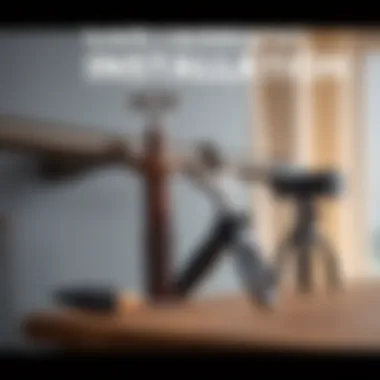
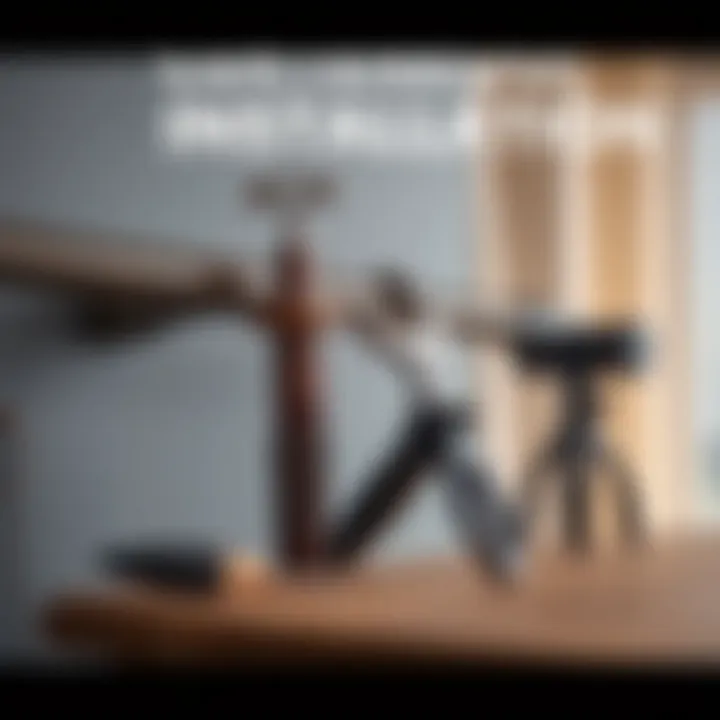
When planning for curtain rod installation, design considerations are crucial not only for aesthetics but also for the overall cost. The way you decide to style your window treatments significantly influences what you will spend on materials and labor. Choosing the right look and function can impact both immediate expenses and long-term satisfaction.
Style Choices
Traditional Styles
Traditional styles often draw from historical designs and can range from opulent drapes in rich fabrics to simple wooden rods with classic finials. One of the key characteristics of traditional styles is their timeless appeal. They evoke a sense of warmth and familiarity, making a space feel inviting.
In terms of costs, traditional styles can sometimes be more expensive due to the higher-quality materials often used, like hardwood for rods and intricate detailing in brackets. However, their durability can justify the initial investment since they tend to last longer and can add value to your home. One downside might be their weight; heavier fabrics typically require stronger hardware, which adds to the installation cost.
Modern Aesthetics
Modern aesthetics embrace clean lines, minimalism, and sometimes an industrial flair. This style often features sleek metal rods and simple designs, allowing for a more playful use of fabric while maintaining an uncluttered feel. The key advantage here is versatility; modern designs can fit seamlessly into various settings while being easier to source and often cheaper than traditional materials.
However, modern aesthetics can sometimes lack the warmth that traditional choices bring. A downside also includes the potential need for custom solutions, especially if the style aligns with unique window shapes, which can increase labor costs. Still, when done right, modern installations emphasize function along with fashion, giving a chic touch to any room.
Functional Requirements
In addition to style, functional requirements play a vital role in determining the costs associated with curtain rod installation. These requirements revolve around practical aspects like light control and privacy.
Light Control
Light control is fundamental in creating a comfortable living environment. For rooms where you might want to block out light completely—like a bedroom—investing in heavier, lined curtains on robust rods may be worthwhile. The unique feature of light control solutions is their ability to create an ambiance and enhance energy efficiency by reducing heat loss or gain.
While opting for more sophisticated light-filtering materials or blackout solutions could steepen costs, the benefits generally outweigh the expenses—especially in climates where energy bills can skyrocket. That said, some may prefer to forego these qualities for sheer aesthetics, which can result in lower costs but compromise functionality.
Privacy Concerns
Privacy concerns often dictate the choice of curtain styles and the materials used for rods. Homes situated close to roads or neighbors may require denser curtains or layered designs. A good feature to consider is that thicker curtains can reduce noise, offering an added benefit along with privacy. However, this may drive up costs due to fabric choices and hardware requirements.
The balance lies in ensuring that what provides privacy also fits within your budget. While intricate designs might cost more, there are plenty of options available that offer both function and aesthetics without breaking the bank. This dual perspective ensures that the curtain rod installation not only suits your design vision but also meets your lifestyle needs.
In essence, both style and function significantly shape the costs involved in curtain rod installation. Understanding your needs can guide you towards making better decisions that provide lasting satisfaction.
Through these considerations, homeowners and designers gain insight into tailoring their projects sensibly, ensuring that investments are sound and serve both immediate and long-term goals.
Alternative Options for Curtain Rod Installation
When it comes to curtain rod installation, traditional methods might not always be the best fit for your specific needs or aesthetics. Exploring alternative options can offer flexibility, convenience, and sometimes even cost savings. This section delves into different temporary solutions and innovative mounting techniques that can serve as viable substitutes. Understanding these methods broadens your choices, allowing you to customize your space without the commitment or expense of permanent installations.
Temporary Solutions
Temporary solutions can be a game changer, especially for those who change their decor frequently or reside in rental properties. They provide an easy way to customize and enhance interiors without drilling into walls or making permanent alterations.
Tension Rods
Tension rods are a clever solution for many homeowners and DIYers. These rods utilize pressure to stay in place, providing a snug fit between two surfaces. This unique feature means no tools are required for installation, which is a boon for those who may lack DIY experience. Furthermore, tension rods come in various sizes and designs, making them a highly adaptable choice for various window types.
However, while the ease of use is a significant advantage, it’s worth noting that tension rods may not be suitable for heavy curtains. The weight can cause them to sag or even fall with time. Additionally, if your windows have a wide span, you may need to consider a more robust solution to ensure stability.
Clip-On Options
Clip-on options have become increasingly popular among those seeking simplicity without sacrificing style. These innovative designs often attach directly to the fabric of the curtains, allowing for a clean and minimalistic look. Notably, they're an effective choice for lightweight curtains, making them suitable for spaces where heavy fabric is unnecessary.
The advantage here lies in the time-saving aspect; there's no need for additional hardware, which can lead to a cleaner installation. That said, if you’re searching for a more luxurious hanging solution, clip-on styles might not provide the elegant finish you’re after. They also tend to limit how much movement you can achieve with the curtains themselves.
Innovative Mounting Techniques
For those willing to venture into modern territory, innovative mounting techniques present another layer of possibilities. These solutions can elevate your design game while offering smart functionality that traditional methods might lack.
Magnetic Solutions
Magnetic solutions are a fresh twist on curtain rod installation. These systems utilize magnets to hold up the curtain, providing an effortlessly chic look that can be easily adjusted or removed. The primary appeal of this method is the absence of hardware; there are no brackets or mounts to fuss with. It simplifies the installation process tremendously, making it ideal for temporary setups or those who enjoy rearranging frequently.
However, these systems may not be the best for heavier drapery. Additionally, magnetic strips or mounts need to be installed on compatible surfaces, which could limit their applicability in certain rooms or window types.
Adhesive Mounts
Adhesive mounts stand out as a fantastic alternative for those who prefer simplicity coupled with adaptability. These mounts allow you to secure rods without drilling any holes, perfect for renters or those who are hesitant to commit to a permanent installation. The flexibility that adhesive mounts provide can be particularly attractive in a home environment where setups are altered often.
Despite the benefits, there are a couple of points to keep in mind. Adhesive mounts may not offer the same long-term security as traditional screws and anchors, particularly in high-humidity areas like kitchens or bathrooms where the adhesive might weaken. Moreover, careful removal is necessary to avoid damaging the wall beneath.
Choosing the right installation method is crucial for both aesthetics and functionality. Temporary solutions and innovative techniques offer flexibility that can fit into a wide range of design paradigms.
Maintenance and Long-Term Considerations
Taking care of your curtain rods is key to maintaining both their functionality and appearance. Over time, wear and tear can set in, possibly leading to more significant issues if not addressed. The objective here is to ensure that your curtain rods continue to complement your interior design while still allowing for smooth operation. Regular maintenance routines can prevent costly repairs down the line and ensure that your investment stands the test of time.
Regular Maintenance Practices


Cleaning Tips
Cleaning your curtain rods might seem like a small task, but it goes a long way in keeping them in good shape. Dust and grime can accumulate, especially in high-traffic areas, impacting not only the look but also the function of your rods. A simple microfiber cloth or a soft duster often does the trick. For deeper cleans, a mild soap solution can remove stubborn stains.
The benefit of regular cleaning is twofold. Not only do your rods remain visually appealing, but it also promotes smooth operation. Key characterisitics of this practice make it a no-brainer: it requires minimal time and effort but reaps rewarding effects. Leaving rods dirty can lead to corrosion, especially in metal rods, effectively shortening their lifespan.
Inspection Guidelines
Routine inspection is another integral part of maintaining curtain rods. At least twice a year, take a good look to see if any hardware is loose, if the rods are straight, or if any components need replacing. This proactive approach allows you to catch issues before they develop into bigger problems.
An important feature of these guidelines is that they teach homeowners to be vigilant. Identifying weak spots early saves both time and costly repairs later on. An annual check-up reduces the risk of accidents like falling rods, which could cause damage to both the curtain and the window frame.
Potential Issues and Repairs
Common Problems
No matter how well you maintain your curtain rods, some issues are simply almost inevitable. Common problems include bent rods, loose brackets, or damaged end caps. These issues can affect the functionality of the rods and may lead to more significant headaches, like curtains falling unexpectedly.
Addressing these common issues quickly is vital, and recognizing their characteristics will help homeowners understand when it’s time to act. For instance, loose hardware may not seem urgent but can gradually worsen. Knowing what to look for and being prepared will save time and prevent further damages.
DIY Repair Tips
If you find yourself knee-deep in curtain rod issues, DIY repairs can be a practical solution. Many problems can be fixed with basic tools—a screwdriver or some pliers might be all you need. For instance, tightening screws or replacing a broken end cap can often restore your rods to perfect working condition without breaking the bank.
The uniqueness of these DIY repair tips is that they empower homeowners to take action directly. Understanding simple repairs enables quicker resolutions, which is especially beneficial for those who appreciate maintaining control over their home environment. That immediacy and self-reliance in repairs can impart a sense of satisfaction and accomplishment.
"Routine check-ups not only extend the life of your curtain rods but also enhance your home's overall aesthetic and functionality."
By integrating these maintenance practices, inspections, and simple repairs into your routine, you’ll set a sturdy foundation for keeping your curtain rod installations fresh and functional for years to come.
Cost-Saving Tips for Curtain Rod Installation
Curtain rod installation can be a nagging expense, often sneakily carving a slice out of your home improvement budget. However, there are smart strategies that can help you keep costs down while ensuring a polished look for your windows. This section dives into various cost-saving tips that can significantly reduce your overall expenditure without compromising on quality.
Using these economical approaches not only saves you bucks but can also yield some leverage when it comes to personalizing your living space. Often, a little bit of planning and tactical shopping can go a long way, so let’s break down the best practices.
Choosing the Right Vendor
Comparing Quotes
When it comes to managing costs effectively, comparing quotes is like having a secret weapon in your pocket. By reaching out to multiple vendors, you not only gain a better understanding of the market rates but also unmask the potential deals that might be lurking out there. Each vendor offers their own take on pricing, and by laying these side by side, you create a clearer picture of what’s reasonable.
What's striking here is that some vendors may include installation as a complimentary service, while others may charge an arm and a leg for it. This differentiation makes the comparison process invaluable. However, it's crucial to ensure the quotes are for similar products and services to avoid apple-to-orange discrepancies.
Important: While cheaper isn't always better, fair pricing often correlates with quality service. Don't rush; take your time to gather information.
Understanding Estimates
Estimating costs can often feel like navigating a labyrinth without a map. Understanding estimates from different vendors sheds light on how they derive their numbers. An estimate typically outlines the materials, labor, and any other costs involved, which can help you decipher whether you're getting a fair deal or not.
A well-detailed estimate not only clears the fog around the pricing but also allows you to preemptively ask questions or negotiate terms. Be aware, though, that a vague estimate may lead to hidden charges later, causing your budget to take a hit unforeseen.
Timing Your Purchase
Off-Season Buying
Much like getting a good price on winter clothes in summer, timing can be everything when it comes to curtain rod installation expenses. Off-season buying is a smart way to snag deals, as many home improvement stores reduce prices to move inventory that isn’t in current demand. For instance, shopping during off-peak periods can yield markdowns of up to 50% off.
In addition to the savings, purchasing during less busy times often allows you to receive better customer service since staff are less swamped with other customers. However, one downside to keep in mind is that selections might be limited, so it’s best to have alternative designs or styles in mind.
Sales and Discounts
It’s no secret that savvy shoppers often keep an eye out for sales and discounts. From holiday sales to end-of-season clearances, these periods can offer steep price drops not easily found elsewhere. By utilizing promotional events, you can capitalise on discounts that significantly affect your bottom line.
Incorporating an alert system, whether it be through email newsletters or store apps, can keep you updated on ongoing promotions. Also, be proactive about asking the vendor about upcoming sales when discussing quotes—knowing when to buy can tip the balance in your favour.
To sum it up, these cost-saving strategies can empower you to make more financially savvy decisions while still achieving the desired aesthetic in your home. As the installation rolls out, ensure you keep these tips in mind to maximize your investment.
End
As we wrap up our exploration into the costs related to curtain rod installation, it’s clear that several factors intertwine to shape the final price tag. Understanding each component—from material choices to installation complexities—allows homeowners, designers, and DIY enthusiasts to make informed decisions. This knowledge isn’t just about spending; it’s about getting the most value for your hard-earned money.
Key Takeaways
- Material Selection: The choice of curtain rods, be it wooden, metal, or an unconventional option, can massively sway your budget. Knowing the pros and cons of each material helps in selecting what fits your needs best.
- Installation Variables: Complexity in installation stands as another crucial player. Consider whether your windows require standard mounting or if special reinforcement is needed. The latter can increase costs significantly, so being aware can save surprises later.
- Design Elements: Keeping design considerations in mind can lead to a more cohesive space. Choosing styles that speak to you while weighing their costs will ensure that you not only enjoy the aesthetic but also stay within budget.
The Benefits of a Comprehensive Approach
By breaking down the expenses and planning ahead, you can avoid being blindsided by hidden costs. This proactive approach not only enhances the overall installation experience but ensures you're happy with your choices long after the curtains are drawn.
Final Thoughts
Ultimately, patience and research are your best friends in this journey. Whether you opt for a robust wooden rod that exudes elegance or a sleek metal rod that captures a modern vibe, understanding the interplay of costs ensures that you keep your eyes on the prize. The right installation can elevate the ambiance of your home, translating into satisfaction for years to come.
"Investing in quality fittings today may seem like a step back but can save you heartache tomorrow."
With all these considerations in mind, embarking on your curtain rod installation project should feel less daunting and more like an exciting opportunity to tailor your space.






